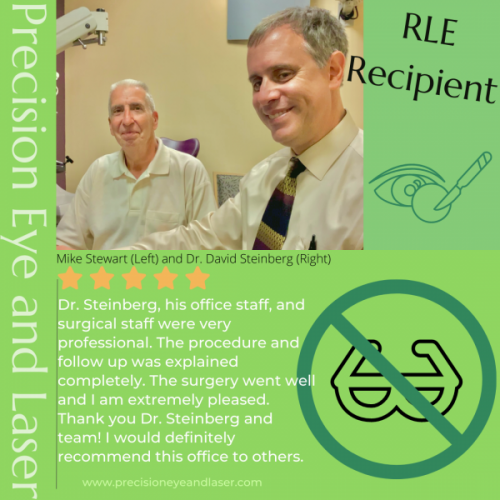Refractive Lens Exchange
If you are over fifty and frustrated with bifocals, this vision correction procedure can provide clear vision at both long distance and near focus. The aging lens of your eye is replaced with an advanced technology multifocal intraocular lens. Patients can typically drive, see TV, read an article, check a price tag, read a menu without dependency on glasses. This ten to fifteen minute outpatient procedure uses a no shot, no stitch, no patch technique that has you back to normal activities the very next day. Please call our office to schedule an informative consultation with the doctor to find out if you are a candidate for this exciting procedure.
About Refractive Lens Exchange (RLE)
Refractive lens exchange (RLE), also known as clear lens extraction, or CLE, is a surgical procedure for vision correction that replaces the natural lens of the eye with an intraocular lens, or IOL. Using the same surgical techniques as cataract surgery, the clear lens of the eye is removed and replaced with an IOL to change the focusing power of the eye.
An alternative to laser vision correction, the RLE procedure avoids the need for a corneal modification that is used during the LASIK procedure, and instead uses the same procedures performed in cataract surgery.
Patients who choose to undergo refractive lens exchange have several options when it comes to the type of IOL that will be implanted into the eye. The RLE procedure uses the same IOLs used in cataract surgery and is able to treat all types of visual disorders, including farsightedness, nearsightedness, presbyopia and astigmatism. Patients are provided with a choice of the most advanced premium IOLs which will allow them to see clearly at all distances.
Candidates for Refractive Lens Exchange
Refractive lens exchange is ideal for patients who:
- Want to reduce or eliminate their dependence on glasses or contact lenses
- Are between the ages of 50 and 75 years of age
- Have high myopia, or nearsightedness, high hyperopia, or farsightedness, presbyopia or astigmatism, with or without cataracts
- Have early symptoms of cataracts
- Are poor candidates for LASIK or PRK
- Have no health issues that affect the eyes
Patients with astigmatism can undergo additional correction during their procedure through relaxing incisions in the outer margins of the cornea, known as Limbal Relaxing Incisions. These incisions create a symmetrical cornea and help reduce or even eliminate astigmatism in the eye. There are also IOLs that correct astigmatism to allow these patients to see clearly.
Benefits of a Refractive Lens Exchange
A refractive lens exchange is an alternative to those patients with corneas that are too thin for a laser vision correction procedure.
Some of the advantages of RLE include the following:
- The rapid recovery of vision
- The cornea remains untouched
- There is no need for cataract surgery in the future
- Vision is now stable
- Correction of near vision at the same time
- Most patients who have RLE will receive a Multiofocal IOL
The Refractive Lens Exchange Procedure
The refractive lens exchange procedure is performed on an outpatient basis using the same techniques as those for cataract surgery.
A topical or local anesthesia is applied to the eyes to minimize discomfort during the procedure. Through a tiny incision of 3mm or less, the natural lens of the eye is removed and replaced with an IOL that is inserted through the same opening. Once inserted, the lens is unfolded and moved into its permanent position in the eye. There are no stitches needed as the incision will be able to seal on its own. The refractive lens exchange procedure takes just 20 minutes to perform and offers patients significant and immediate results.
After the Refractive Lens Exchange Procedure
After a refractive lens exchange, patients can return home the same day, and can return to work and other regular activities after a day or two. Many report immediate improvements to their vision, and vision will continue to improve as the brain adapts to the new lens. Once vision has stabilized, it will likely stay the same over time as the lenses correct vision and prevent the patient from developing cataracts in the future. The second eye is usually treated a few weeks after the first procedure.
The extent of the results of the RLE will depend upon the patients eyes, lifestyle and the IOL selected for the procedure. Many patients are able to eliminate their dependence on glasses or contacts after this procedure, while others may still need glasses for driving or reading.
Risks and Complications of a Refractive Lens Exchange
All surgery carries some degree of risk. These concerns should be discussed, in detail, with the surgeon.
The risks and complications of a refractive lens exchange are the same as those of cataract surgery and may include:
- Retinal detachment
- Increased pressure in the eye
- Infection
- Bleeding
- Ptosis
- Sensitivity to light
- Dry eyes
- Glaucoma
- Distortion in vision
- Halos around lights

